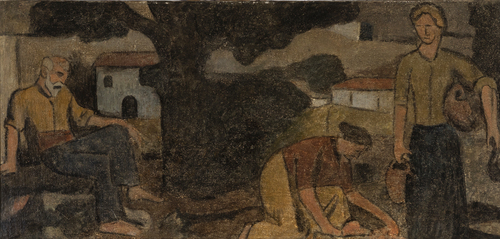This is custom heading element
From a very early age, despite being born into a family of merchants and artisans with no cultural concerns, Torres García showed great artistic sensitivity. He was self-taught in creation, and it was thanks to his insistence that his parents (his father was Catalan, his mother Uruguayan) gave in to his desire to leave Montevideo and travel to Barcelona.
The stay in Barcelona left a tremendous mark on the man who would become the creator of Constructive Art. Always ready to allow himself to be impregnated by the latest developments, Torres-García was subjugated by the cultural effervescence that was buzzing in the Catalan capital, where he arrived in 1891. He joined the group of intellectuals and artists who promoted Noucentisme, a movement that reacted against the “decadent” sophistication of Art Nouveau and established a relationship with nature and primitive history that manifested itself in pastoral scenes of the Mediterranean golden age. As a member of this influential group, the Uruguayan painter became one of the most recognized artists in Barcelona at the beginning of the 20th century.
This is evidenced by the scale of the commissions and projects he carried out, such as the frescoes for the Saló de Sant Jordi of the Palau de la Generalitat de Catalunya, or the famous painting “Philosophy presented by Pallas in Parnassus”. These works are part of the return to the norms established by the classicism advocated by Eugenio d’Ors.
Although it also belongs to the Barcelona period, the painting “Classical Figures” already moves away from the Noucentist postulates. This work is a valuable link in the very personal path that the artist was clearing for himself and that would lead him to a revulsive reinvention of the pictorial practice.
In this landscape landscape with figures, painted in tempera, although the noucentista imprint remains through the reinterpretation of classicism and the interest in placing the characters in a rural environment, the way of resolving the bodies and applying the colors already warn us of a search radically different from the one carried out by the Catalan group. In the way of economizing the forms and synthesizing the line, as well as in the adaptation of the palette to a range of ochre and sienna tones, a certain Cezannian beat can be appreciated.
In this landscape, of studied composition, with an olive tree compartmentalizing the scene, the three bodies are enclosed in their own gestures and thoughts while harmoniously molding themselves to the scene. Houses have been described with the same eagerness to schematize the world, to reduce life to its essence.
Barcelona, which at the time was home to some of those who were to revolutionize art forever, such as Picasso himself, with whom Torres García must have coincided more than once in “Els Quatre Gats”, at a time when the Uruguayan painter was working with Gaudí on the stained glass windows of the Sagrada Familia, was the cradle of the man who was to become the driving force behind “universalist constructivism”. Specifically, “Classical Figures”, foreshadows his great contribution to the history of modern art.





